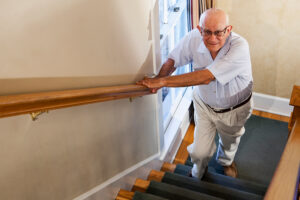June 7, 2022

Senior mobility issues may seem to crop up unexpectedly, but there are several signs to watch for.
Benjamin Franklin certainly had it right: An ounce of prevention is really worth a pound of cure. When it comes to noticing and addressing senior mobility issues, prevention is essential. Falls in older adults lead to 3 million emergency room visits, 300,000 hip fractures, and 32,000 deaths each year, according to research by the CDC.
Preempt a tragedy by keeping an eye out for these warning signs of increasing senior mobility issues:
- Experiencing dizziness. Dizziness and difficulties with balance can arise from a plethora of factors that ultimately cause difficulty with mobility. It’s important to uncover why these problems are taking place and address them as soon as possible.
- Skipping physical activity. Another warning sign is an older adult who previously engaged in some degree of exercise but now is choosing a much more sedentary lifestyle. Weakness or exhaustion can result in issues with mobility.
- Steering clear of stairs. A senior who appears to be getting around just fine but is avoiding going up or down stairs could be fearful of falling because of mobility changes.
- Struggling to sit or stand. Notice whether the older adult finds it hard to either stand up from a seated position or to sit back down. Do they need something to hold onto for support?
One easy and effective method to gauge mobility and fall risk in older adults is the TUG (Timed Up and Go) test. The test should be carried out on a regular basis. Here is all it requires:
- Place a sturdy chair up against the wall.
- Mark a distance of 10’ from the wall.
- Have the individual sit in the chair.
- When you tell them to go, start a timer, and have the person stand, walk towards the ten foot mark, turn around, come back and sit down again.
Remember to stand close by while the older adult performs the test to provide support if required. Track the outcome over a period of time and share with the person’s physician for guidance. Find additional information about the test along with a downloadable one-page evaluation sheet.
If you pick up on any of these signs, it’s time to have a frank conversation with the senior. Let the person know you’re concerned, and schedule an appointment for a check-up with the physician. The utilization of some simple mobility aids can make an enormous amount of improvement in maintaining independence and safety.
Contact Continuum, a trusted provider of home care management and senior care services for additional fall prevention strategies for older adults, and to find out about the countless ways we can improve quality of life for a senior you love.
